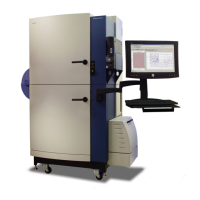FLIPR
®
Tetra High Throughput Cellular Screening System User Guide
0112-0109 H 153
bottom of the well uniformly. The following quantities are
recommended:
96-well plate, 100 μL/well
384-well plate, 40 μL/well
1536-well plate, 6 μL/well
6. Check the plate visually to make sure there are no bubbles or
unfilled wells. Shake or tap the microplate to dislodge any
bubbles. Keep the MQAE plate covered and in the dark until
used.
7. Use the MQAE plate as the Flat Field calibration plate in step 7 of
the Recalibrating the Optics on page 150.
Running a Signal Test
When to Perform a Signal Test:
• Once a day to check the system.
• Prior to performing an experiment to check the protocol
settings.
System Check
Once a day, before running your first assay plate, run a signal test to
ensure the system is performing according to specifications. A yellow
signal test plate is available for each corresponding pipettor head
supplied with the system.
Although both Fluorescence and Luminescence are available in the
signal test window, currently there is no easy way of testing signal
strength in Luminescence mode. It is therefore recommended to run
daily checks of Yellow Plate Signal Test in Fluorescence to check optical
performance of the instrument and use the Protocol Signal Test only for
Fluorescence experiments only.
CAUTION! Store the signal test plate in a safe place away from bright
light on an even surface. Avoid scratching the plate bottom as scratches
can affect the standard deviation.
Note: To ensure proper system functioning, make sure that the
system is turned on and the standard EMCCD camera is cooled to -60
°C ± 2 °C, or the Aequorin ICCD camera is cooled to -20 °C ± 5 °C.

